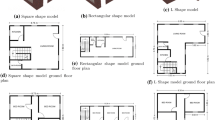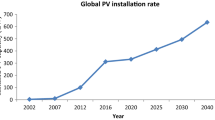Abstract
This paper is comprehended in the study of the application of the biomimicry science in building services and energy management, taking as a reference the case of tuna. Tuna generates heat in the muscles, organs and tissues of the inner area of its body (dark muscles). This heat is distributed in the periphery in order to maintain constant body temperature. From this biological reality, researchers analyse the possibility of altering the heating demand of an office on the basis of the heat conservation strategy applied by tuna, merely modifying the working-spaces. For this purpose, an existing office building with high architectonical quality parameters has been chosen and different scenarios have been defined in order to perform the energy simulations. The case studies correspond to the variations in the floor layout and occupancy density distribution. Besides, they are studied in three European cities with different climate. The evaluation of results is mainly focused on the heating demand since tuna strategy comprises the heat management. It is shown that the arrangement of high thermal load locals affects the heating demand of the building, being more efficient the tuna distribution in order to lower the demand.

Similar content being viewed by others
References
Azar E, Menassa C (2012). A comprehensive analysis of the impact of occupancy parameters in energy simulation of office buildings. Energy and Buildings, 55: 841–853.
Badarnah L, Kadri U (2014). A methodology for the generation of biomimetic design concepts. Architectural Science Review, 58: 120–133.
Bar-Cohen Y (2006). Biomimetics-using nature to inspire human innovation. Bioinspiration & Biomimetics, 1: 1–12.
Baumeister D, Tocke R, Dwyer J, Ritter S, Benyus JM (2014). Biomimicry Resource Handbook: A Seed Bank of Best Practices, 2014 edn. Missoula, USA: CreateSpace Independent Publishing Platform.
Benyus JM (1997). Biomimicry: Innovation Inspired by Nature. New York: Harper Collins.
Blank JM, Morrissette JM, Farwell CJ, Price M, Schallert RJ Block B (2007). Temperature effects on metabolic rate of juvenile pacific bluefin tuna thunnus orientalis. The Journal of Experimental Biology, 210: 4254–4261.
Bluyssen PM, Aries M, van Dommelen P (2011). Comfort of workers in office buildings: The European HOPE Project. Building and Environment, 46: 280–288.
Bonte M, Thellier F, Lartigue B (2014). Impact of occupant’s actions on energy building performance and thermal sensation. Energy and Buildings, 76: 219–227.
Bragança L, Vieira S, Andrade JB (2014). Early stage design decisions: The way to achieve sustainable buildings at lower costs. The Scientific World Journal, doi: 10.1155/2014/365364.
Carey FG, Teal JM, Kanwisher JW, Lawson KD, Beckett JS (1971). Warm-bodied fish. American Zoologist, 11: 137–143.
Carey FG, Teal JM (1966). Heat conservation in tuna fish muscle. Proceedings of the National Academy of Sciences of the United States of America, 56: 1464–1469.
Dai C, Lan L, Lian Z (2014). Method for the determination of optimal work environment in office buildings considering energy consumption and human performance. Energy and Buildings, 76: 278–283.
De Gutierrez-Mahoney C, Schechter M (1972). The myth of the rete mirabile in man. Neuroradiology, 158: 141–158.
Eguaras-Martinez M, Martín-Gómez C, Vidaurre-Arbizu M, Brennan T, Krinidis S, Ioannidis D, Tzovaras D (2014a). Architectural simulation of the integration of building information modelling (BIM) & business process modelling (BPM). In: Proceedings of 10th European Conference on Product and Process Modelling (ECPPM), Vienna, Austria.
Eguaras-Martínez M, Vidaurre-Arbizu M, Martín-Gómez C (2014b). Simulation and evaluation of building information modeling in a real pilot site. Applied Energy, 114: 475–484.
Güçyeter B, Günaydin HM (2012). Optimization of an envelope retrofit strategy for an existing office building. Energy and Buildings, 55: 647–659.
Guerra-Santin O, Itard L (2012). The effect of energy performance regulations on energy consumption. Energy Efficiency, 5: 269–282.
Guglielmetti R, Macumber D, Long N (2011). OpenStudio: An open source integrated analysis platform. In: Proceedings of 12th International IBPSA Building Simulation Conference, Sydney, Australia.
Hill RW, Wyse GA, Anderson M (2015). Animal Physiology. Available at: http://www.sinauer.com/animal-physiology.html. Accessed 16 Mar 2015.
Hillebrand G, Arends G, Streblow R, Madlener R, Müller D (2014). Development and design of a retrofit matrix for office buildings. Energy and Buildings, 70: 516–522.
Hong T (2012). Occupant behavior: Impact on energy use of private offices. In: Proceedings of 1st IBPSA Asia Conference (ASim), Shanghai, China.
Ioannidis D, Tzovaras D, Malavazos C (2012). Occupancy and business modelling. In: Proceedings of 9th European Conference on Product and Process Modelling (ECPPM), Reykjavik, Iceland.
Kalz DE, Pfafferott J (2014). Thermal Comfort and Energy-Efficient Cooling of Nonresidential Buildings. Cham, Switzerland: Springer International Publishing.
Knight I, de Souza C (2007). Modelling cooling demands in UKoffice buildings: The impact of using 3 different strategies to assess internal gains. In: Proceedings of 10th International IBPSA Building Simulation Conference, Beijing, China.
Liu L, Zhao J, Liu X, Wang Z (2014). Energy consumption comparison analysis of high energy efficiency office buildings in typical climate zones of China and U.S. based on correction model. Energy, 65: 221–232.
Lo J, Novoselac A (2010). Localized air-conditioning with occupancy control in an open office. Energy and Buildings, 42: 1120–1128.
Lo SH, Peters GJY, van Breukelen GJ, Kok G (2014). Only reasoned action? An interorganizational study of energy-saving behaviors in office buildings. Energy Efficiency, 7: 761–775.
Ma Z, Cooper P, Daly D, Ledo L (2012). Existing building retrofits: Methodology and state-of-the-art. Energy and Buildings, 55: 889–902.
Malte H, Larsen C, Musyl M, Brill R (2007). Differential heating and cooling rates in bigeye tuna (thunnus obesus lowe): A model of non-steady state heat exchange. The Journal of Experimental Biology, 210: 2618–2626.
Martinaitis V, Zavadskas EK, Motuziene V, Vilutiene T (2015). Importance of occupancy information when simulating energy demand of energy efficient house: A case study. Energy and Buildings, 101: 64–75.
Martinez A, Carlson A (2014). State of the art methodology to assess energy facade retrofits (EFR). In: Proceedings of ARCC/EAAE 2014 International Conference on Architectural Research—Beyond Architecture: New Intersections & Connections, Honolulu, USA, pp. 372–381.
Meir IA, Garb Y, Jiao D, Cicelsky A (2009). Post-occupancy evaluation: An inevitable step toward sustainability. Advances in Building Energy Research, 3: 189–219.
Morrissey J, Sumich J (2011). Introduction to the Biology of Marine Life, 10th edn. Sudbury, MA, USA: Jones & Bartlett Learning.
Moschonas P, Krinidis S, Ioannidis D, Tzovaras D (2014). Building performance simulation using business process modelling. In: Proceedings of European Conference on Product and Process Modelling (ECPPM): eWork and eBusiness in Architecture, Engineering and Construction. National Laboratory of the U.S.
Department of Energy (2015). OpenStudio. Available at https://www.openstudio.net/.
Nik Eteghad A, Usón Guardiola E, Hosseini Raviz SR, Armesto Aira A (2015). Re-visiting performance-based design in pursuance of passive techniques manifested in Thomas Herzog’s architecture. ACE: Architecture, City and Environment, 9(27): 47–68.
Nolte I, Strong D (2011). Europe’s Buildings under the Microscope. Brussel: Buildings Performance Institute Europe (BPIE).
O’Brien W, Gunay HB (2014). The contextual factors contributing to occupants’ adaptive comfort behaviors in offices—A review and proposed modeling framework. Building and Environment, 77: 77–87.
Orosa JA, Oliveira AC (2009). Energy saving with passive climate control methods in Spanish office buildings. Energy and Buildings, 41: 823–828.
Pawlyn M (2011). Biomimicry in Architecture. London: RIBA Publishing Group.
Pedersen Zari M (2007). Biomimetic approaches to architectural design for increased sustainability. In: Proceedings of Sustainable Building Conference, Auckland, New Zealand.
Peel MC, Finlayson BL, McMahon TA (2007). Updated world map of the Köppen-Geiger climate classification. Hydrology and Earth System Sciences, 11: 1633–1644.
Roetzel A, Tsangrassoulis A, Dietrich U (2014). Impact of building design and occupancy on office comfort and energy performance in different climates. Building and Environment, 71: 165–175.
Shao Y, Geyer P, Lang W (2014). Integrating requirement analysis and multi-objective optimization for office building energy retrofit strategies. Energy and Buildings, 82: 356–368.
Shashua-Bar L, Hoffman ME (2004). Quantitative evaluation of passive cooling of the UCL microclimate in hot regions in summer, case study: Urban streets and courtyards with trees. Building and Environment, 39: 1087–1099.
Stevens ED, Lam HM, Kendall J (1974). Vascular anatomy of the counter-current heat exchanger of skipjack tuna. Journal of Experimental Biology, 61: 145–153.
U.S. Department of Energy (2015). EnergyPlus Energy Simulation Software: Legacy OpenStudio SketchUp Plug-In. U.S. Department of Energy.
Vincent J (2009). Biomimetic patterns in architectural design. Architectural Design, 79(6): 74–81.
Wilson AJ, Templeman AB (1976). An approach to the optimum thermal design of office buildings. Building and Environment, 11: 39–50.
Climate Data (2015). World Climate Data—Temperature, Weather and Rainfall. Available at http://www.climatedata.eu/. Accessed 14 May 2015.
Yedeki Arslan G (2014). Biomimetic architecture: A new interdisciplinary approach to architecture. ALAM CRIPTA, International Journal of Sustainable Tropical Design Research and Practice, 7(2): 29–36.
Author information
Authors and Affiliations
Corresponding author
Rights and permissions
About this article
Cite this article
Zuazua-Ros, A., Martín-Gómez, C., Bermejo-Busto, J. et al. Thermal energy performance in working-spaces from biomorphic models: The tuna case in an office building. Build. Simul. 9, 347–357 (2016). https://doi.org/10.1007/s12273-016-0273-8
Received:
Revised:
Accepted:
Published:
Issue Date:
DOI: https://doi.org/10.1007/s12273-016-0273-8




